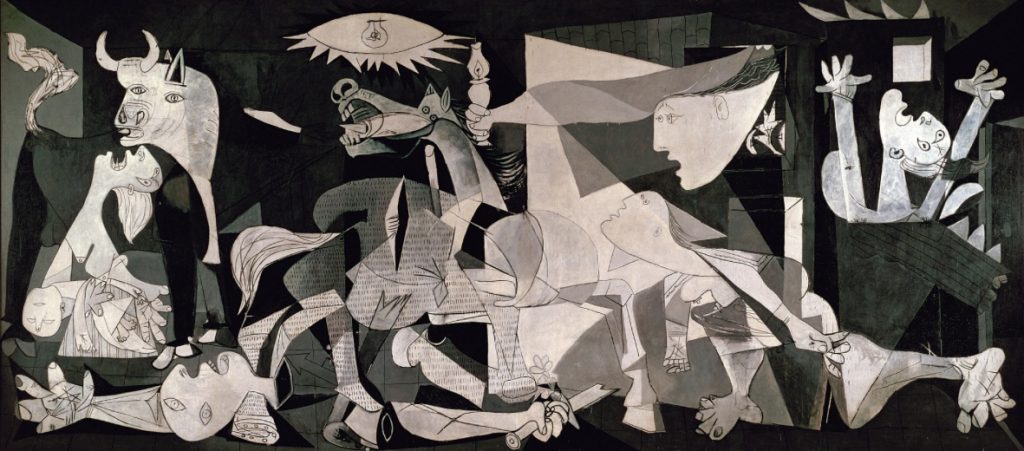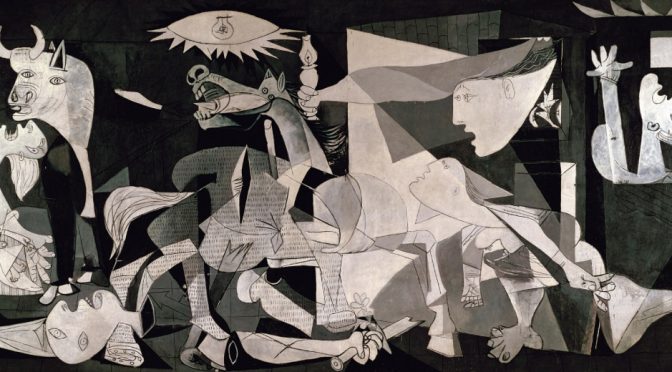Tomorrow marks 84 years since the bombing of Gernika, that day during the Spanish Civil War when Hitler’s Air Force, at the behest of Franco, bombed the civilian population of the Basque village on a Monday, market day. It was one of the first aerial bombings of a civilian population, though other Basque towns, notably Durango, had been bombed earlier but without the same press coverage. The bombing and destruction of this sacred Basque town generated wide-spread shock and anger. It also inspired Pablo Picasso to paint his now-iconic masterpiece Guernica.

- When Picasso was first commissioned to paint a mural for the Spanish pavilion in the 1937 World’s Fair, he was at a bit of a loss as to what his subject would be. Something anti-fascist, to be sure, and he played with scenes of Franco eating his horse and fighting a bull. But, it wasn’t until the bombing of Gernika that he found his inspiration. Immediately after the bombing, he was visited by poet Juan Larrea, who urged him to make the bombing the topic of his mural. On May 1, Picasso read the accounts of George Steer, who described the complete destruction of the Basque town. Picasso finally had his subject.
- Picasso never revealed what symbolism he intended in the elements of the painting, saying “this bull is a bull and this horse is a horse.” Rather, while he didn’t deny there was symbolism, he said it came from the painting, not from something he intended to place in the painting.
- Guernica was first displayed in July 1937 at the World’s Fair. Initially, it didn’t draw much attention and even received significant criticism for its style (“jerky” and “too compressed for its size” by art critic Clement Greenberg) and its message, criticized by Marxists for not depicting a more hopeful future.
- However, immediately after, it went on tour, first in Scandinavia and then the United Kingdom, before making its way to the United States. It continued to tour across the US, South America, and Europe until concern for its condition kept it at the Museum of Modern Art in New York until 1981. In 1974, it was vandalized, the words “kill lies all” painted in big red letters on the canvas, a response to the Mỹ Lai massacre in the Vietnam War.
- Picasso had forbidden the painting from going to Spain until after it was again a republic. The death of Franco and the establishment of the new government eventually led to the painting finding its permanent home in Spain, in Madrid. There have been requests to move the painting to the Basque Country, at least for an exhibition, but the curators argue it is too fragile for such a move.
- A tapestry of the painting, originally commissioned by Nelson Rockefeller when Picasso refused to sell him the original, has hung at the entrance of the Security Council at the United Nations beginning in 1985, with a break from 2009-2015. It was famously covered in 2003 when Colin Powell was making the case for the war against Iraq. In February 2021, the Rockefeller family took the tapestry back.
Primary source: Guernica (Picasso), Wikipedia
Discover more from Buber's Basque Page
Subscribe to get the latest posts sent to your email.



I first saw the original Guernica mural 5 years ago and have returned twice to Guernika researching a novel that revolves around, the bombing of Guernika, the 4000 Ninos who were evacuated to the UK and the mural, Guernica. It’s an art work that has resonated for freedom from war and oppression since it was first exhibited in Paris in 1937. Thank you for your reminder.
Thank you for commenting. I’ve only seen the original once, when I was too young and naive to really appreciate it. I need to go back.